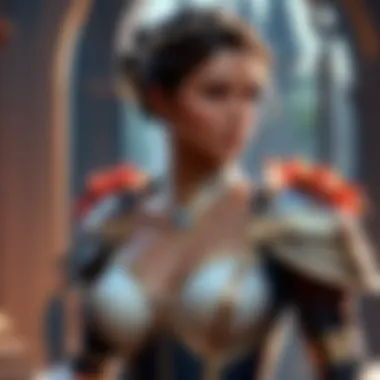Exploring the Multifaceted Realm of Classic Artistry: An In-Depth Analysis


Game Overview
Subsection: List of Key Elements in the Classic Spectrum
Within the classic spectrum lie an array of key elements worth discerning and dissecting. These elements, ranging from timeless aesthetics to enduring narratives, hold the essence of classic manifestations. By dissecting these constituent parts, we illuminate the depths of classic influence, aligning perspectives and perceptions to appreciate the richness it offers in diverse environments. Embracing each core element unravels a tapestry of tradition, innovation, and lasting legacy that defines the classic spectrum.
Subsection: Relevance of Classic in Modern Contexts
Understanding classic elements within a modern context is essential to unravel the enduring relevance and adaptability. By scrutinizing classic features in contemporary settings, we decipher their transformative power and timelessness across generations. Navigating the convergence of classic and modernity unravels a discourse on evolution, preservation, and reinterpretation, illustrating the seamless blend of tradition with innovation. Observing how classic influences resonate in today's society offers a unique vantage point into the continuum of culture, aesthetics, and values.
Introduction to Classic Elements
In the realm of artistic expression and cultural significance, Classic Elements hold a pivotal role in shaping our understanding of aesthetics and design. This section serves as the anchor for our exploration into the intricate world of classic attributes. By delving deep into the essence of classic elements, readers are guided through a journey that unravels the profound meanings and subtle nuances embedded within classicism. Understanding these foundational elements is crucial to appreciating the timeless allure and enduring appeal of classic aesthetics across various domains of human creativity and expression.
Defining Classic
The essence of classicism lies in its adherence to timeless principles that transcend fleeting trends and fads. Classic design and artistic motifs are characterized by their intrinsic quality of timelessness and enduring beauty. This subsection delves into the essence of what defines a creation as 'classic' and explores how these elements set the standard for excellence and sophistication in diverse fields of art, architecture, literature, and more. By grasping the core principles that underpin classicism, readers gain insight into the meticulous craftsmanship and thoughtful curation that define classic creations.
Historical Evolution
The historical evolution of classicism traces back to ancient civilizations and philosophies that laid the foundation for its enduring legacy. From the Greco-Roman influences to the Renaissance period and beyond, classicism has continually reinvented itself while staying true to its fundamental principles. This subsection dissects the progression of classic elements through history, shedding light on pivotal moments and movements that shaped the course of aesthetic traditions. By exploring the historical evolution of classicism, readers gain a profound understanding of how past ideologies and artistic conventions continue to resonate in contemporary creations.
The Origin of Classic Concepts
At the core of classic concepts lies a rich tapestry of ideals and principles that have withstood the test of time. The origins of classicism can be traced back to ancient civilizations such as Greece and Rome, where notions of symmetry, balance, and harmony laid the groundwork for artistic expression. This subsection elucidates the pivotal role of ancient philosophies in shaping the concept of classicism, highlighting the enduring influence of these foundational ideas on modern creative practices.
Influence of Classicism Throughout History


Throughout history, classicism has served as a beacon of inspiration for artists, architects, and thinkers across civilizations. The enduring legacy of classicism can be seen in the architectural marvels of antiquity, the masterpieces of Renaissance art, and the intellectual pursuits of Enlightenment thinkers. This subsection explores how classicism has permeated various facets of human endeavor, leaving an indelible mark on cultural and artistic movements through the ages.
Characteristics of Classicism
Classicism is characterized by a set of defining attributes that embody grace, elegance, and balance in creative expressions. This subsection unpacks the key characteristics that define classicism, from the emphasis on symmetry and balance to the pursuit of harmony and proportion. By dissecting these core traits, readers gain a deeper appreciation for the meticulous attention to detail and artistic refinement that distinguish classic creations from contemporary trends.
Symmetry and Balance
Central to the essence of classicism is the emphasis on symmetry and balance in composition and design. The pursuit of equilibrium and harmonious proportions imbues classic creations with a sense of order and serenity that transcends temporal constraints. This subsection explores how symmetry and balance serve as pillars of classic aesthetics, guiding artists and designers in their quest for timeless beauty and enduring appeal.
Elegance and Simplicity
The allure of classicism lies in its simplicity and understated elegance, which eschew excess in favor of refined minimalism. Classic creations exude a sense of effortless sophistication and refined taste, capturing the essence of understated luxury. This subsection delves into the interplay between elegance and simplicity in classic design, showcasing how these qualities elevate artistic expressions to transcendent realms of beauty and meaning.
Harmony and Proportion
Harmony and proportion form the bedrock of classical aesthetics, guiding creators in their quest for visual balance and emotional resonance. The integration of harmonious elements and proportionate ratios infuses classic works with a sense of unity and coherence that captivates the beholder. This subsection examines how harmony and proportion collaborate to create a sense of visual rhythm and emotional depth in classic compositions, elevating them to the realm of timeless masterpieces.
The Intersection of Classic with Modernity
Classic Revival in Contemporary Culture
Within contemporary culture, there exists a profound resurgence of classic themes and motifs, reflecting a nostalgic yearning for the elegance and sophistication of bygone eras. This revival not only pays homage to the past but also revitalizes classical ideals in present-day expressions of art, fashion, and media. The assimilation of classic elements serves to enrich and diversify the cultural landscape, fostering a deeper appreciation for historical legacies and their enduring impact on contemporary creativity.
Adaptation of Classic Elements in Design
Integration of Classical Architecture in Modern Structures
The integration of classical architecture into modern structures symbolizes a harmonious blend of timeless aesthetic principles with functional design requirements. This fusion not only preserves architectural heritage but also infuses contemporary spaces with a sense of grandeur and sophistication. The key characteristic of this integration lies in its ability to establish a visual dialogue between the past and the present, creating compelling contrasts that elevate the overall architectural composition. While offering a link to history, the integration of classical architecture also poses challenges in terms of spatial efficiency and adaptation to modern technological needs.


Utilization of Classic Artistic Motifs in Contemporary Art
The utilization of classic artistic motifs in contemporary art provides artists with a rich tapestry of visual vocabulary to draw upon, transcending temporal boundaries and fostering a dialogue between tradition and innovation. This creative symbiosis allows for the reinterpretation and reinterpretation of classical themes and symbols in fresh, imaginative ways. The unique feature of this approach lies in its ability to evoke a sense of cultural continuity while offering new perspectives on age-old narratives. However, the utilization of classic artistic motifs also prompts questions of originality and the balance between homage and artistic innovation.
Influence of Classic Literature on Modern Narratives
Themes of Classicism in Contemporary Novels
The infusion of classic themes in contemporary novels adds layers of depth and complexity to storytelling, enriching narratives with timeless motifs and moral quandaries. By exploring themes rooted in classicism, modern writers engage with universal human experiences and ethical dilemmas that resonate across epochs. The key characteristic of this adaptation is its capacity to bridge literary traditions, transcending time and cultural boundaries to create a forum for dialogue between past and present perspectives. However, navigating the legacy of classic literature in modern narratives requires a delicate balance between homage and creative reinterpretation.
Reinterpretation of Classic Stories in Film and Media
The reinterpretation of classic stories in film and media not only breathes new life into beloved tales but also invites audiences to rediscover familiar narratives through a contemporary lens. This dynamic process of adaptation involves exploring iconic stories from fresh angles, reimagining characters and plots to suit modern sensibilities while preserving the core essence of the original tales. The unique feature of this reimagining lies in its ability to resonate with diverse audiences, offering a compelling blend of nostalgia and innovation. However, the reinterpretation of classic stories also raises questions about the authenticity of adaptations and the fidelity to the source material within the constraints of modern storytelling formats.
The Cultural Impacts of Classic Elements
In the journey of exploring classic elements, it becomes evident that their cultural impacts hold significant relevance within this comprehensive analysis. Classic elements serve as the foundation upon which societal norms are built, influencing behavior, perceptions, and artistic expressions. By delving into the realm of classicism's role in shaping societal norms, we uncover deep-rooted connections between traditional aesthetics and modern values, highlighting the enduring influence of classic principles on contemporary societies. This section provides a nuanced discussion on how classic elements have historically shaped cultural paradigms and continue to play a pivotal role in defining shared values and aesthetics.
Classicism's Role in Shaping Societal Norms
The role of classicism in shaping societal norms emerges as a critical focal point in understanding the broader implications of classic elements. Through an analysis of historical contexts and cultural developments, we gain insights into how classic aesthetics have permeated societal structures, influencing everything from architecture to art to fashion. Classicism not only reflects past traditions but also sets a standard for cultural expression, fostering a sense of continuity and coherence in the ever-evolving world. By unraveling the intricate connections between classic elements and societal norms, we come to appreciate the timeless relevance of classical ideals in shaping collective identities and aesthetic preferences.
Classic Influences in Global Architecture
Classic influences in global architecture offer a fascinating lens through which to examine the transcultural significance of classic elements in built environments. From classic architectural marvels scattered across the world to the enduring legacy of classic design principles in urban planning, this subsection delves into the intertwined relationship between architectural history and contemporary construction practices. By delving into the distinct characteristics of classic architectural marvels worldwide, we uncover the enduring appeal of symmetry, proportion, and craftsmanship in architectural design. Similarly, the exploration of the legacy of classic design in urban planning showcases how timeless architectural principles continue to inform urban landscapes, creating harmonious cityscapes that blend the old with the new seamlessly. -#### Classic Architectural Marvels Around the World
The presence of classic architectural marvels around the world serves as a testament to the enduring legacy of classical design principles. These marvels not only showcase the architectural prowess of bygone eras but also embody cultural and historical narratives that enrich our understanding of the built environment. By highlighting key characteristics of iconic structures such as the Parthenon in Greece or the Colosseum in Rome, we appreciate the meticulous craftsmanship and symbolic significance infused within these architectural wonders. However, their preservation and conservation pose ongoing challenges in balancing heritage conservation with modern usability, presenting a complex interplay between the past and the present in architectural discourse. -#### Legacy of Classic Design in Urban Planning
The legacy of classic design in urban planning underscores the timeless principles that continue to shape contemporary cityscapes worldwide. Whether through urban layouts inspired by classical symmetry or public spaces designed with a nod to historic city planning, the influence of classic design remains palpable in modern urban environments. By examining the advantages and disadvantages of integrating classic design principles into urban planning, we unravel the complexities of preserving heritage while fostering sustainable development and livability in urban centers, thus paving the way for a thoughtful reflection on the role of classicism in shaping future cityscapes.


Classic Motifs in Pop Culture Phenomena
The infusion of classic motifs into pop culture phenomena signifies a fascinating evolution of traditional aesthetics in contemporary expressions. Through an exploration of iconic classic references in pop music and classic inspirations in fashion trends, we discover how classic elements continue to inspire and influence popular culture trends. From music to fashion, classic motifs offer a timeless allure that resonates with audiences across generations, bridging the gap between historical traditions and modern creativity. -#### Iconic Classic References in Pop Music
Iconic classic references in pop music reflect a creative interplay between past musical traditions and present-day expressions, showcasing how classical compositions and themes endure within mainstream culture. By dissecting key characteristics of classic references in popular music, we uncover the nostalgic appeal and artistic depth that classic motifs bring to contemporary music production. However, balancing homage to classic compositions with innovative creativity poses a delicate balance for modern musicians, as they navigate between honoring tradition and charting new sonic territories. -#### Classic Inspirations in Fashion Trends
Classic inspirations in fashion trends exemplify the cyclical nature of style evolution, where vintage aesthetics find new life in contemporary clothing designs. Through an analysis of how classic elements influence current fashion trends, we gain insights into the enduring popularity of timeless silhouettes, patterns, and fabrics in the ever-changing landscape of the fashion industry. By highlighting the advantages and disadvantages of incorporating classic inspirations into fashion, we navigate the fine line between nostalgia and innovation, offering a glimpse into the dynamic interplay between classic aesthetics and modern couture.
The Timeless Allure of Classic Aesthetics
In this crucial section of the article, we delve deep into the enduring fascination with classic aesthetics. Understanding the importance of preserving classic elements amidst modernity is paramount in appreciating timeless beauty. The allure of classic aesthetics lies in its ability to transcend trends and evoke a sense of sophistication and refinement. By exploring the significance of classic aesthetics, readers can grasp its role in shaping cultural perceptions and fostering a deeper appreciation for heritage and tradition.
Enduring Appeal of Classic Beauty Standards
Classic beauty standards hold a significant place in societal ideals and personal perceptions of attractiveness. They encapsulate timeless features and proportions that have resonated across generations, emphasizing grace, symmetry, and poise. Discussing the enduring appeal of classic beauty standards highlights the enduring influence of these ideals on contemporary notions of beauty and elegance. It offers insights into how these standards continue to shape aesthetic preferences and redefine beauty in a shifting cultural landscape.
Classic Elegance in Visual Arts
Classic Art Movements and Their Influence
Within the realm of visual arts, classic art movements have played a pivotal role in defining artistic expression and aesthetic principles. These movements, such as the Renaissance or Neoclassicism, have left indelible marks on art history, influencing generations of artists and art enthusiasts. By examining classic art movements and their influence, one can appreciate the enduring legacy of techniques, themes, and styles that have withstood the test of time.
Representation of Classic Elements in Contemporary Artworks
The representation of classic elements in contemporary artworks signifies a dynamic interplay between tradition and innovation. Artists often draw inspiration from classical motifs, reinventing them in modern contexts to create compelling and thought-provoking pieces. Exploring how contemporary artists reinterpret classic elements sheds light on the evolving nature of artistic expression and the dialogue between past and present in the visual arts landscape.
Classic Influence on Personal Style
Incorporating Classic Fashion Pieces
The incorporation of classic fashion pieces into personal style reflects a timeless approach to dressing that transcends fleeting trends. Classic fashion pieces, such as tailored blazers or elegant dresses, embody enduring style and sophistication, serving as wardrobe staples that stand the test of time. Understanding the significance of incorporating classic fashion pieces offers insights into building a versatile and elegant wardrobe that exudes timeless charm and refined taste.
Embracing Timeless Elegance in Everyday Dressing
Embracing timeless elegance in everyday dressing signifies a conscious choice to prioritize quality, simplicity, and longevity in one's personal style. By embracing classic elements in daily outfits, individuals can cultivate a signature look that oozes sophistication and confidence. Delving into the nuances of timeless elegance in everyday dressing encourages readers to rethink their approach to fashion and embrace a more curated and refined aesthetic.



